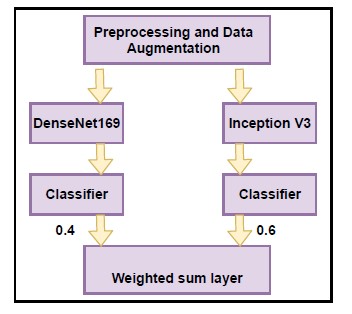Recent News
- Metaheuristics attribute selection model for efficient diagnosis of chronic disorders May 31, 2022
 The technological advancements in the medical domain have aided in the effective collection of data such as personal information, clinical history, and disease symptoms of patients. However, the accumulation of massive quantity of data may cause errors in the diagnosis of the disease. A chronic disease dataset may be comprised of numerous symptoms and attributes where not all of them are of equal importance in disease diagnosis. A few of those attributes may be less relevant or redundant.
The technological advancements in the medical domain have aided in the effective collection of data such as personal information, clinical history, and disease symptoms of patients. However, the accumulation of massive quantity of data may cause errors in the diagnosis of the disease. A chronic disease dataset may be comprised of numerous symptoms and attributes where not all of them are of equal importance in disease diagnosis. A few of those attributes may be less relevant or redundant.Through her research, Dr Priyanka from the Department of Computer Science and Engineering proposes metaheuristics driven attribute optimization techniques that can be implemented in optimizing chronic disease datasets to achieve optimal efficiency in disease risk prediction which can help in proper medical diagnosis. Her paper titled “A Decisive Metaheuristics Attribute Selector Enabled Combined Unsupervised-Supervised Model for Chronic Disease Risks Assessment” was published in the Q1 journal Computational Intelligence and Neuroscience.
 This research can be used to develop a decision support system to assist medical experts in the effective analysis of chronic diseases in a cost-effective manner. The system model may be used to assist medical experts in the efficient diagnosis of chronic disease risks. In future, the research study can be further enhanced to validate the model on more complex heterogeneous datasets with varying sizes and structures. Also, deep learning methods can be employed using image-based real-time datasets.
This research can be used to develop a decision support system to assist medical experts in the effective analysis of chronic diseases in a cost-effective manner. The system model may be used to assist medical experts in the efficient diagnosis of chronic disease risks. In future, the research study can be further enhanced to validate the model on more complex heterogeneous datasets with varying sizes and structures. Also, deep learning methods can be employed using image-based real-time datasets.Abstract of the Research
Advanced predictive analytics coupled with an effective attribute selection method plays a pivotal role in precise assessment of chronic disorders risks in patients. In this paper, a novel buffer enabled heuristic a Memory based Metaheuristics Attribute Selection (MMAS) model is proposed, which performs local neighbourhood search for optimizing chronic disorders data. Heart disease, breast cancer, diabetes and hepatitis are the datasets used in the research. Upon implementation of the model, a mean accuracy of 94.5% using MMAS was recorded and it dropped to 93.5% if clustering was not used. The average precision, recall and f-score metric computed were 96.05%, 94.07% and 95.06% respectively. The model also has a least latency of 0.8 sec. Thus it is demonstrated that chronic disease diagnosis can be significantly improved by heuristics based attribute selection coupled with clustering followed by classification.
Figure 1: The proposed Metaheuristics attribute selector based classification model for chronic disorders detection
Figure 2: Accuracy analysis of MMAS method on different disease datasets
Continue reading → - Advanced research on secure transmission of medical images February 5, 2022
 SRM University-AP promotes translational research that can add value to society making lives better. Following the tradition, Dr Priyanka Singh, Assistant Professor and her PhD student Ms Jyothsna Devi from the Department of Computer Science and Engineering have published their recent research work “Region-based Hybrid Medical Image Watermarking Scheme for Robust and Secured Transmission in IoMT” in ‘IEEE Access journal’ (Impact Factor of 3.36).
SRM University-AP promotes translational research that can add value to society making lives better. Following the tradition, Dr Priyanka Singh, Assistant Professor and her PhD student Ms Jyothsna Devi from the Department of Computer Science and Engineering have published their recent research work “Region-based Hybrid Medical Image Watermarking Scheme for Robust and Secured Transmission in IoMT” in ‘IEEE Access journal’ (Impact Factor of 3.36).Dr Priyanka’s research focuses on the healthcare industry that is rapidly transforming medical images into ones that operate in real-time environments (IoMT, IoT, Cloud and so on). The research is proposed to address security and integrity issues in medical image transmission on IoT and edge healthcare applications with a lossless reversible region-based MIW scheme.
In this era of technological advancement, medical images and patient information are widely transmitted through a public transmission channel on the Internet of Medical Things (IoMT) applications. While sharing medical images or electronic patient records (EPR) through a public network, they can get tampered with or manipulated, leading to the wrong diagnosis by the medical consultants. Confidentiality of the patient record is also a major concern. Thus, it is very important to ensure the authenticity, authorisation, integrity, and confidentiality of the information during transmission.
ABSTRACT:
With the growth in Internet and digital technology, the Internet of Medical Things (IoMT) and Telemedicine have become buzzwords in healthcare. A large number of medical images and information are shared through a public network in these applications. This paper proposes a region-based hybrid Medical Image Watermarking (MIW) scheme to ensure the authenticity, authorisation, integrity, and confidentiality of the medical images transmitted through a public network in IoMT. In the proposed scheme, the medical image is segmented into Region of Interest (RoI) and Region of Non-Interest (RoNI).
RoI tamper detection and recovery bits are embedded in RoI to ensure the integrity of the medical image. RoI is watermarked using adaptive Least Significant Bit (LSB) substitution with respect to the hiding capacity map for higher RoI imperceptibility and accuracy in tamper detection and recovery. Electronic Patient Record (EPR) is compressed using Huffman coding and encrypted using a pseudo-random key (secret key) to provide higher confidentiality and payload. Encrypted EPR, QR code of hospital logo and RoI recovery bits are embedded in RoNI using Discrete Wavelet Transform-Singular Value Decomposition (DWT-SVD) hybrid transforms to achieve a robust watermark.
The proposed scheme is tested under various geometric and non-geometric attacks such as filtering, compression, rotation, salt and pepper noise and shearing. The evaluation results demonstrate that the proposed scheme has high imperceptibility, robustness, security, payload, tamper detection, and recovery accuracy under image processing attacks. Therefore, the proposed scheme can be used in the transmission of medical images and EPR in IoMT. The relevance of the proposed scheme is established by its superior performance in comparison to some of the popular existing schemes.
Continue reading → - Detection of diabetic retinopathy (DR) severity from fundus photographs November 19, 2021
 A research paper titled “Detection of Diabetic Retinopathy (DR) severity from fundus photographs: An Ensemble Approach using weighted average”, has been published by Dr Mahesh Kumar Morampudi, Assistant Professor of Computer Science and Engineering, in the Arabian Journal for Science and Engineering.
A research paper titled “Detection of Diabetic Retinopathy (DR) severity from fundus photographs: An Ensemble Approach using weighted average”, has been published by Dr Mahesh Kumar Morampudi, Assistant Professor of Computer Science and Engineering, in the Arabian Journal for Science and Engineering.Diabetic Retinopathy is a common diabetic disease that affects the retina and can result in blindness if not treated initially. Deep learning (DL) based models are proposed to detect the blood abnormalities in the retinal tissue due to diabetes mellitus obtained from fundus camera. The drawback of these models is the lack of performance. To address this, we propose to automate the process of detection of the severity of Diabetic Retinopathy (DR) using ensembles of pre-trained models, thus exploring the power of transfer learning in the field of automated diagnosis. Deep learning models perform well when the model is trained on a large amount of data. In this regard, we also put forth data augmentation and preprocessing techniques to generate synthetic images and to improve image quality. Extensive experimental results on publicly available databases illustrate that the proposed ensemble model achieves fair accuracy when compared to existing models. Thus, the proposed model shows good scope for deployment in real-time diagnosis.
Every year multiple people are diagnosed with diabetes. Diabetes is a chronic disease that affects several organs of the human body namely the eyes, kidneys, heart etc. Diabetic Retinopathy (DR) is a situation induced by diabetes in which severe loss happens to the retinal blood vessels that can ultimately lead to blindness. Regular diabetic retinopathy screening is hence needed for detecting it in advance. In the present situation, a trained clinician or an ophthalmologist is required to identify diabetic retinopathy (DR) by the existence of lesions related to the vascular abnormalities induced by the disease. The ophthalmologist needs to evaluate and examine digital colour fundus images of the retina. So, it is a very tedious and sluggish process. He/She needs more time to diagnose DR. The diagnosis of the disease by any manual means seems to be tiresome and usually results in errors. To overcome this limitation, we propose a model to automate the process of detection of the severity of DR using ensembles of pre-trained models, thus exploring the power of transfer learning in the field of automated diagnosis.
The research group believes that the study helps ophthalmologists to identify diabetic retinopathy at its early stage accurately, as a result, the chance of losing the vision due to diabetic retinopathy can be reduced. The work is done in collaboration with Dr Mulagala Sandhya, Assistant professor, NIT-Warangal. In the future, Dr Mahesh Kumar plans to work on a project related to Privacy-preserving Biometric Authentication.
Continue reading → - Third year CSE students innovate efficient plastic recycling technology September 17, 2021
 Swikriti Khadke, Pragya Gupta, and Shanmukh Rachakunta from third-year Computer Science Engineering have published a research paper titled “Efficient Plastic Recycling and Remold Circular Economy using the Technology of Trust – Blockchain” along with their mentors from SRM University-AP Dr Jatindra Kumar Dash, Dr Goutam Kumar Dalapati and Dr Sabyasachi Chakrabortty in the peer-reviewed journal Sustainability.
Swikriti Khadke, Pragya Gupta, and Shanmukh Rachakunta from third-year Computer Science Engineering have published a research paper titled “Efficient Plastic Recycling and Remold Circular Economy using the Technology of Trust – Blockchain” along with their mentors from SRM University-AP Dr Jatindra Kumar Dash, Dr Goutam Kumar Dalapati and Dr Sabyasachi Chakrabortty in the peer-reviewed journal Sustainability.Global plastic waste is increasing rapidly. The strategic management of plastic waste and recycling can preserve environmental species and associated costs. The utilization of plastic can be done by introducing Blockchain during plastic waste recycling. Automation for the segregation and collection of plastic waste can effectively establish a globally recognizable tool using Blockchain-based applications. Collection and sorting of plastic recycling are feasible by keeping track of plastic with unique codes or digital badges throughout the supply chain. Efficient recycling technology is essential to reduce plastic pollution. Many technologies have been employed to enhance plastic recycling. Among them, blockchain is promising for plastic recycling and circular economy (CE). Blockchain, a distributed ledger, consists of some ordered blocks which are unchangeable. This can be considered an exemplary way to push the transactions of their customers under the same blockchain technology. The research group used machine learning techniques to predict plastic generation globally so that they could see the impact it will make in the coming future. The students have used ARIMA – Auto-Regressive Integrated Moving Average for the study.
The potential idea is to utilize an approach wherein recyclers can keep track of generated waste as it moves through the various chains. A platform that works by tracking recycling activities across a local recycling supply chain on the Blockchain. When this will be publicly available, consumers can also use the ledger info to make more informed purchasing decisions. The Blockchain can be utilized to track individual items through the recycling supply chain by creating physical markers like QR codes.
The suggested Blockchain-based platform can be implemented in various nations with an autonomous waste collector and storage system. This process can be expanded to individual collectors and storage systems. The novel process will be created by incorporating a reward-based Blockchain scheme with the collaboration of global businesses and local waste collectors. The proposed model further allows the effective sharing of databases among various supply chains to create a CE.
Talking about the social implications of the research, the students firmly believe that the study will result in the introduction of new technology in the recycling industry and promote awareness about technology in rural areas. Developing a platform and implementing blockchain and other facilities will be the focus of these young innovative brains of SRM University-AP in the forthcoming days.
Read the full paper here: https://doi.org/10.3390/su13169142
Continue reading → - SVS Sri Harsha gets admission in leading IIMs across India June 18, 2021
 SVS Sri Harsha, a final-year BSc Computer Science student at SRM University-AP, Andhra Pradesh, receives admission offers from India’s top business schools. As an extremely meritorious student, he has qualified CAT, XAT, NMAT and SNAP. He scored a percentile of 98.9 in CAT and has got the opportunity to study MBA at any one of the IIMs in Shillong, Kozhikode, Raipur, and Bodh Gaya. In addition to these apex management institutes, he has also received offers from XLRI-Xavier School of Management, Jamshedpur; Institute of Management Technology, Ghaziabad; NMIMS, Mumbai; Symbiosis Institute of Business Management, Pune; and International Management Institute, Delhi. He hails from Vijayawada and completed his schooling in Delhi.
SVS Sri Harsha, a final-year BSc Computer Science student at SRM University-AP, Andhra Pradesh, receives admission offers from India’s top business schools. As an extremely meritorious student, he has qualified CAT, XAT, NMAT and SNAP. He scored a percentile of 98.9 in CAT and has got the opportunity to study MBA at any one of the IIMs in Shillong, Kozhikode, Raipur, and Bodh Gaya. In addition to these apex management institutes, he has also received offers from XLRI-Xavier School of Management, Jamshedpur; Institute of Management Technology, Ghaziabad; NMIMS, Mumbai; Symbiosis Institute of Business Management, Pune; and International Management Institute, Delhi. He hails from Vijayawada and completed his schooling in Delhi.“I started my preparation for CAT from the end of March 2020 and successfully achieved the percentile. I am extremely happy that I got calls from reputed institutes in the country as it was my dream to pursue an MBA from any one of these institutes after completing my bachelor studies”, said Harsha. “I would like to express my gratitude to the computer science head of the department, Dr T Ragunathan, and the faculty members for their unwavering support throughout my academic journey at SRM University-AP” he added.
Continue reading →

